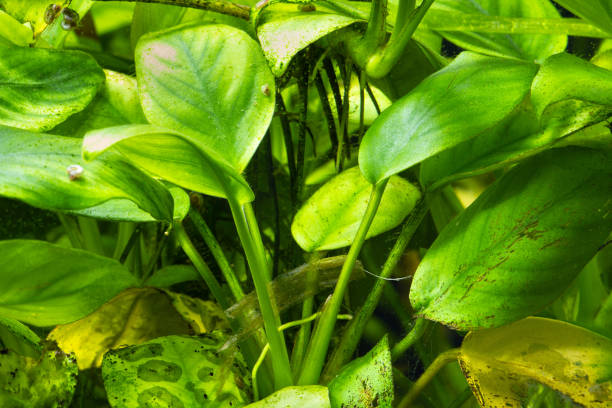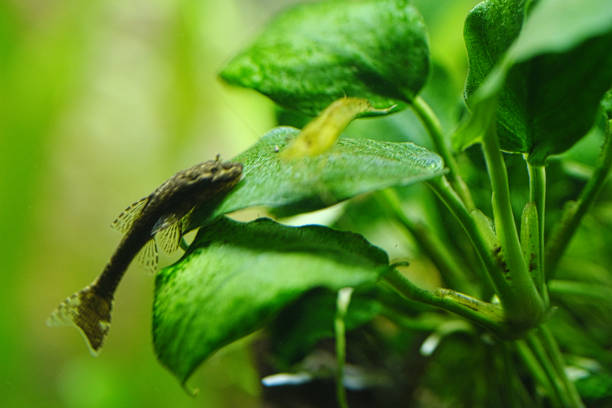Anubias is considered among the most popular aquatic plants for beginners. Not only are these plants hardy and easy to take care of, but they are also cheap and available almost everywhere. Furthermore, anubias make for a great leafy background should you need your tank to look more natural.
Thus, many people are determined to learn how to grow anubias fast. If you are one of them, scroll down and keep reading!
Contents
How To Grow Anubias Fast – Follow These 8 Steps

Before getting down to growing anubias, you will need several tools to help secure the aquarium plants. These include potted anubias, holey rocks or aquarium rocks and driftwood with structures, and glue gel.
Now, once the supplies are already in place, let’s get down to growing these plants!
Step 1: Take the plants out of the pots. Carefully remove the remnants of the plant rock wool, which surround the roots themselves.
If the wool gets stuck with the roots, you may want to use gently running water to get rid of the dirt and the sticky material. Use your fingers and make sure the roots of the anubias are fully exposed.
Step 2: Look for rhizomes scattered around the anubias plant. This aquatic plant does not need to be planted using its roots, but rather its rhizomes. Hence, it is important that you find out where this particular body part is located, which is usually placed between the roots and the leaves.
Step 3: Find natural crevices on the driftwood or substrate to start placing your anubias plant. You should consider whether this spot is well-lit and can easily be reached by fertilizers or not.
Step 4: Dry the roots and the rhizome using a piece of cloth or paper towels. This helps the plant itself attach to the surface easily.
Step 5: Spray the glue gel onto the surface where you will be planting your anubias. Rest assured that the gel will not tamper with the growth of your plants. On the contrary, it will be useful to keep the plant in its place once the growth spurt starts to happen.
Step 6: Slowly and gently hold the plant vertically. Press the roots and rhizome onto the rock, then keep the whole thing there for about 1 to 2 minutes. Your plants will soon become permanently attached to this surface.
Step 7: Repeat the process above until you have already planted all of your anubias. Make sure to do this as quickly as you can, since aquatic plants may die down if left outside for too long.
Step 8: Proceed to put the anubias-filled rocks inside your aquarium. And ta-da, you are done!
While the planting of anubias is easy enough, providing them with a suitable environment to grow substantially is much more important. If you wish your anubias to develop as fast as possible, you will need to keep the water algae-free.
Furthermore, clean the water and remove the organic waste as regularly as you can, since anubias do not enjoy being submerged in dirty water. Last but not least, an occasional CO2 pump will be vital if your anubias want to be more robust.
FAQs
Does anubias need fertilizer?
Not necessarily. Anubias can be left on their own and are still capable of growing rather quickly. That said, if you want a bit of a push for anubias to stay healthy for a long period, consider using some types of liquid fertilizers.
Since these fertilizers can be dissolved into the water, they will be easier for anubias to absorb. You can learn more about it in this article.
Do anubias need to be fully submerged?
No. Anubias can be grown either fully or partly submerged. However, this can only apply to its body. As far as the roots and rhizome are concerned, these two parts need to stay underwater.
Since these are where anubias get their nutrients and water supply, cutting them off from the water will render the plant helpless.
What temperature does anubias like?
Anubias is a big fan of lukewarm water. Anything between 73 to 83 degrees Fahrenheit will be best for the growth of these aquatic plants.
However, if it is too difficult for you to maintain the ideal temperature range, rest assured that anubias can still endure a wide selection of water temperatures.
How many hours of light do anubias need?
Anubias thrive when being exposed to low lighting for an extended period. For the best result, it is recommended that you keep anubias under LED light or sunlight for at least 8 to 10 hours per day.

Once you have achieved the recommended dose of light for your plants, you might want to cover the tank or find a way to minimize the exposure of anubias to the light. This is because too much light will lead to algae – a sworn enemy that threatens to tamper with the growth of your plant.
Do anubias have to be attached?
Anubias do not do well when left floating inside the water for a long time. Thus, you are advised to plant these plants on a fixed surface.
Not only does this help you take easy care of your anubias, but it also ensures that the plants can stay healthy and unaffected by strong water currents in the long term.
Conclusion
How to grow anubias fast should not be a concern of yours once you have finished reading this article. Make sure to follow the tips and tricks above and your tank will be filled with the loveliest aquatic plants in no time!

